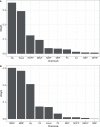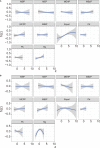Combined Exposure to Multiple Endocrine Disruptors and Uterine Leiomyomata and Endometriosis in US Women
- PMID: 34489871
- PMCID: PMC8418539
- DOI: 10.3389/fendo.2021.726876
Combined Exposure to Multiple Endocrine Disruptors and Uterine Leiomyomata and Endometriosis in US Women
Abstract
Background: Uterine leiomyomata (UL) and endometriosis (EM) are common gynecological diseases damaging the reproductive health of fertile women. Among all the potential factors, environmental endocrine-disrupting chemicals are insufficiently addressed considering the multiple pollutants and mixture exposure.
Methods: Women aged 20 to 54 years old in the National Health and Nutrition Examination Survey (NHANES) 2001-2006, having a complete measurement of ten commonly exposed endocrine-disrupting chemicals (including urinary phthalate metabolites, equol, and whole blood heavy metals) and answered questions about UL and EM were included (N=1204). Multivariable logistic regression model, weighted quantile sum (WQS) regression, and Bayesian kernel machine regression (BKMR) models were implemented to analyze the combined effect of chemicals on the overall association with UL and EM.
Results: In single chemical analysis, equol (OR: 1.90, 95% CI: 1.11, 3.27) and mercury (Hg) (OR: 1.91, 95% CI: 1.14, 3.25) were found positively associated with UL in tertile 3 vs. tertile 1. In WQS regression and BKMR models, the significant positive association between WQS index and UL (OR: 2.54, 95% CI: 1.52, 4.29) was identified and the positive relationship between equol and Hg exposure and UL were further verified. Besides, the mixture evaluation models (WQS and BKMR) also found MEHP negatively associated with UL. Although none of the single chemicals in tertile 3 were significantly associated with EM, the WQS index had a marginally positive association with EM (OR: 2.01, 95% CI: 0.98, 4.15), and a significant positive association was identified in subanalysis with participants restricted to premenopausal women (OR: 2.18, 95% CI: 1.03, 4.70). MIBP and MBzP weighted high in model of EM and MEHP weighted the lowest.
Conclusion: Comparing results from these three statistical models, the associations between equol, Hg, and MEHP exposure with UL as well as the associations of MIBP, MBzP, and MEHP exposure with EM warrant further research.
Keywords: Bayesian kernel machine regression (BKMR); endometriosis; mixed exposure; uterine leiomyomata; weighted quantile sum (WQS) regression.
Copyright © 2021 Zhang, Lu, Ma, Xu and Wu.
Conflict of interest statement
The authors declare that the research was conducted in the absence of any commercial or financial relationships that could be construed as a potential conflict of interest.
Figures




Similar articles
-
Urinary phytoestrogens and the risk of uterine leiomyomata in US women.BMC Womens Health. 2023 May 13;23(1):261. doi: 10.1186/s12905-023-02381-5. BMC Womens Health. 2023. PMID: 37179289 Free PMC article.
-
Association of exposure to phthalates with endometriosis and uterine leiomyomata: findings from NHANES, 1999-2004.Environ Health Perspect. 2010 Jun;118(6):825-32. doi: 10.1289/ehp.0901543. Epub 2010 Feb 25. Environ Health Perspect. 2010. PMID: 20185384 Free PMC article.
-
Using three statistical methods to analyze the association between exposure to 9 compounds and obesity in children and adolescents: NHANES 2005-2010.Environ Health. 2020 Aug 31;19(1):94. doi: 10.1186/s12940-020-00642-6. Environ Health. 2020. PMID: 32867766 Free PMC article.
-
Environmental exposures to endocrine disrupting chemicals (EDCs) and their role in endometriosis: a systematic literature review.Rev Environ Health. 2020 Sep 9;36(1):101-115. doi: 10.1515/reveh-2020-0046. Print 2021 Mar 26. Rev Environ Health. 2020. PMID: 32903210
-
Endocrine-disrupting chemicals and uterine fibroids.Fertil Steril. 2016 Sep 15;106(4):967-77. doi: 10.1016/j.fertnstert.2016.08.023. Epub 2016 Aug 21. Fertil Steril. 2016. PMID: 27553264 Free PMC article. Review.
Cited by
-
Reversing Uteropathies Including Cancer-Like Changes in Mice by Transplanting Mesenchymal Stromal Cells or XAR Treatment.Stem Cell Rev Rep. 2024 Jan;20(1):258-282. doi: 10.1007/s12015-023-10632-z. Epub 2023 Oct 2. Stem Cell Rev Rep. 2024. PMID: 37779174
-
Benzo[a]pyrene disrupts LH/hCG-dependent mouse Leydig cell steroidogenesis through receptor/Gαs protein targeting.Sci Rep. 2024 Jan 8;14(1):844. doi: 10.1038/s41598-024-51516-7. Sci Rep. 2024. PMID: 38191651 Free PMC article.
-
Environmental Exposure to Non-Persistent Endocrine Disrupting Chemicals and Endometriosis: A Systematic Review.Int J Environ Res Public Health. 2022 May 5;19(9):5608. doi: 10.3390/ijerph19095608. Int J Environ Res Public Health. 2022. PMID: 35565013 Free PMC article.
-
The association between dietary inflammatory index with endometriosis: NHANES 2001-2006.PLoS One. 2023 Apr 26;18(4):e0283216. doi: 10.1371/journal.pone.0283216. eCollection 2023. PLoS One. 2023. PMID: 37099512 Free PMC article.
-
A Prospective Ultrasound Study of Whole Blood Metals and Incidence of Uterine Leiomyomata.Environ Health Perspect. 2025 Apr;133(3-4):47012. doi: 10.1289/EHP15218. Epub 2025 Apr 25. Environ Health Perspect. 2025. PMID: 40063901 Free PMC article.
References
Publication types
MeSH terms
Substances
LinkOut - more resources
Full Text Sources
Medical

